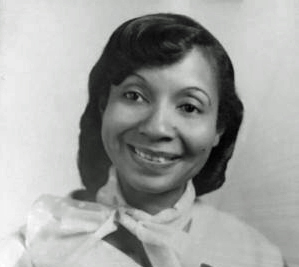Dorothy McFadden Hoover facts for kids
Quick facts for kids
Dorothy McFadden Hoover
|
|
|---|---|
 |
|
| Born |
Dorothy Estheryne McFadden
July 1, 1918 Hope, Arkansas, US
|
| Died | February 7, 2000 (aged 81) |
| Education |
|
| Occupation | Physicist, mathematician |
| Employer | NACA, NASA |
| Known for | Pioneering theoretical mathematics research at NACA and NASA |
| Spouse(s) |
|
Dorothy Estheryne McFadden Hoover (born July 1, 1918 – died February 7, 2000) was an amazing American physicist and mathematician. She was a true pioneer during the early days of NASA. Dorothy was one of the first black women hired at Langley. She started as a "human computer" and later became a published physicist and mathematician.
Hoover was one of the first black women to be named as a co-author on NASA research papers. Her important work helped create America's first jet fighter, the Sabre. You can learn more about her achievements in the popular book Hidden Figures.
| Top - 0-9 A B C D E F G H I J K L M N O P Q R S T U V W X Y Z |
Early Life and Education
Dorothy Estheryne McFadden was born in Hope, Arkansas, on July 1, 1918. Her parents were William and Elizabeth Wilburn McFadden. She was the youngest of four children. Her grandparents had been enslaved people.
Dorothy finished high school when she was just 15 years old. She then went to Arkansas Agricultural, Mechanical, and Normal College (AM&N). In 1938, she earned her Bachelor of Science degree in Mathematics. This was just two months before her 20th birthday.
A Career at NASA
After teaching for a few years in Georgia, Dorothy continued her studies. In 1943, she earned her master's degree in mathematics from Atlanta University. Soon after, she was hired by the National Advisory Committee for Aeronautics (NACA). This agency later became NASA.
Dorothy started working at Langley in 1943 as a professional mathematician. She joined a group of women, both black and white, who were hired as "human computers." Their job was to help develop new aircraft technology during World War II.
Breaking Barriers at Langley
When Hoover first started, Langley was segregated. Black women were assigned to work in a separate area called the West Area of Computing. Dorothy showed great talent and promise there. Because of her skills, she became one of the first West Area computers to join an integrated research group. This meant she worked alongside people of all races.
Hoover then worked directly with Robert T. Jones, a famous NASA engineer. He was known as one of the best aeronautical engineers of his time. By 1946, Dorothy's calculations were highly trusted by Jones. Her work became very important to the field of aeronautics.
Published Research
Dorothy Hoover became one of the first black women to have her work published by NACA/NASA. In 1951, she co-authored two important articles with Frank S Malvestuto. These articles focused on "thin sweptback tapered wings" for aircraft.
Their research helped improve the design of high-speed aircraft. This included planes used by the military and for civilian travel. Even today, her design ideas are used in aircraft that fly at supersonic speeds. This includes commercial planes, fighter jets, and even the space shuttle!
After Langley
In 1952, Hoover left Langley as an aeronautical research scientist. She continued her education and earned a second master's degree in physics in 1954. This degree was from the University of Arkansas. A part of her master's thesis was even published in a science journal.
She returned to government work, first at the U.S. Weather Bureau. Later, she transferred to NASA's Goddard Space Flight Center. At Goddard, Hoover made history again. She became the first Black woman to be promoted to a GS-13 position. This was a very important job within the U.S. federal government.
After she retired, Dorothy Hoover wrote a book. It was about the history of the African Methodist Episcopal Church. The book was called A Layman Looks with Love at Her Church.
Later Life and Legacy
Dorothy Hoover passed away in Washington, D.C., in 2000. Her contributions to mathematics and physics helped shape modern aviation. She paved the way for many others in science and engineering.
See also
 In Spanish: Dorothy McFadden Hoover para niños
In Spanish: Dorothy McFadden Hoover para niños

